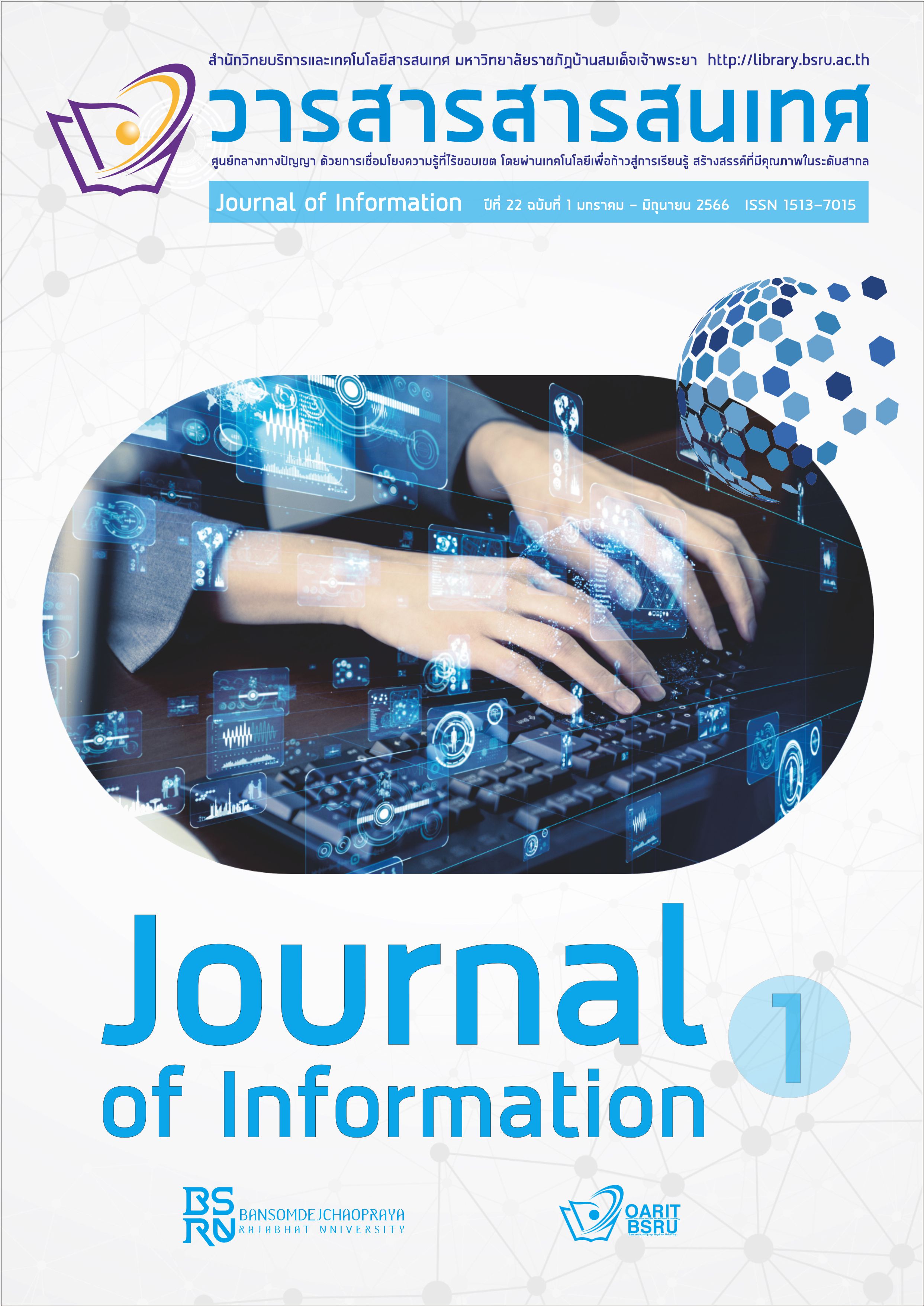The Developing Innovative Digital Media for Mobile Learning Platforms
Keywords:
Digital media innovation, Learning platform, Mobile deviceAbstract
The objectives of this research were as follows: to develop and testing the effectiveness , to examine the effectiveness index and study the acceptance of digital media innovation for learning platforms in internet technology and web development course via mobile device. The sample group was 21 students in the Department of Animation and Digital Media. Bansomdejchaopraya Rajabhat University enrolled in Internet Technology and Web Development course, Academic year 1/2564, obtained by Cluster random sampling. The research tool is an innovative digital learning medium for mobile learning platforms, performance assessment form, pre-test assessment, post-test assessment and the digital media innovation acceptance assessment form. The statistics used in the data analysis were mean, standard deviation, t-test, Dependent Samples, E1/E2 efficiency, and E.I.
Research findings revealed that: the efficacy evaluation was a efficacy value of 82.41/80.63 which was higher than criteria 80/80, comparing the learning achievements after learning was higher than before learning at .05 level of significance and the increase in student development can be assessed by the effectiveness index (E.I.) equal to 0.7007, the sample group was 70.07 percent improvement in learning and the acceptance digital media innovation at a high level ( =4.22 S.D. = 0.55)
References
ธนกร เริงเกษตรกรณ์. (2560, 27 กรกฎาคม). การพัฒนาบทเรียนออนไลน์รายวิชาการพัฒนาโปรแกรมบนอุปกรณ์เคลื่อนที่สำหรับนักศึกษาระดับปริญญาตรี วิทยาลัยเทคโนโลยีสยาม [เอกสารนำเสนอ]. การประชุมวิชาการระดับชาติ ครั้งที่ 3 และระดับนานาชาติ ครั้งที่ 1: กรุงเทพฯ, ประเทศไทย.
วิไลวรรณ วงศ์จินดา. (2564). แพลตฟอร์มการเรียนรู้เพื่อการพัฒนาทักษะการเรียนในศตวรรษที่ 21. คณะครุศาสตร์อุตสาหกรรม. มหาวิทยาลัยเทคโนโลยีราชมงคลสุวรรณภูมิ.
สมรักษ์ นันตา และคณะ. (2564, 22 กุมภาพันธ์). บทเรียนออนไลน์ เรื่อง การใช้โปรแกรม Scratch วิชาการเขียนโปรแกรมสำหรับสำหรับนักเรียนชั้นมัธยมศึกษาปีที่ 2 โรงเรียนนครไตรตรึงษ์. รายงานสืบเนื่องจากการประชุมวิชาการระดับชาติ สำหรับนักศึกษา มหาวิทยาลัยราชภัฎกำแพงเพชร ครั้งที่ 1: กำแพงเพชร, ประเทศไทย.
สำนักงานคณะกรรมการพัฒนาการเศรษฐกิจและสังคมแห่งชาติ. (2562). ยุทธศาสตร์ชาติ (พ.ศ. 2561 -2580) สำนักงานคณะกรรมการพัฒนาการเศรษฐกิจและสังคมแห่งชาติ. ผู้แต่ง.
สำนักงานเลขาธิการสภาการศึกษา. (2561). สภาวะการศึกษาไทยปี 2559/2560 แนวทางการปฏิรูปการศึกษาไทยเพื่อก้าวสู่ยุค Thailand 4.0. ผู้แต่ง.
อภิฤดี ทองพล.(2563). การพัฒนาบทเรียนออนไลน์ผ่านอุปกรณ์เคลื่อนที่เพื่อส่งเสริมการรู้สารสนเทศของนักศึกษาระดับปริญญาตรี มหาวิทยาลัยราชภัฏอุดรธานี. ว.วิจัย สมาคมห้องสมุดแห่งประเทศไทย.13(1),35-50.
Davis, F. D., Bagozzi, R. P. & Warshaw, P.R. (1989). User acceptance of computer technology: A comparison of two theoretical models. Management Science. 35(8), 982-1003.
Deng, L. & Ma, W. (2018). New Media for Educational Change. Springer.
Liu, I-F., Chen, M.C., Sun, Y.S., Wible, D., & Kuo, C-H. (2010). Extending the TAM model to explore the factors that affect intention to use an online learning community. Computers & Education. 54, 600-610.
O'Brien, E., McCarthy, J., Hamburg, I., & Delaney, Y. (2019). Problem-Based Learning in the Irish SME Workplace. Journal of Workplace Learning. 31(6), 391-407.
Sánchez-Franco, M.J., Martínez-López, F.J. & Martín-Velicia, F.A. (2009). Exploring the impact of individualism and uncertainty avoidance in Web-based electronic learning: An empirical analysis in European higher education. Computer & Education. 52, 588-598.
Sheng, Z., Jue, Z., & Wiewie, T. (2008). Extending TAM for Online Learning System: An Intrinsic Motivation Perspective. Tsighua Science and Technology. 13(3), 312-317.
Downloads
Published
How to Cite
Issue
Section
License

This work is licensed under a Creative Commons Attribution-NonCommercial-NoDerivatives 4.0 International License.
บทความ ข้อความ ภาพประกอบ และตารางประกอบที่ลงพิมพ์ในวารสารเป็นความคิดเห็นส่วนตัวของผู้นิพนธ์ กองบรรณาธิการไม่จำเป็นต้องเห็นตามเสมอไป และไม่มีส่วนรับผิดชอบใดๆ ถือเป็นความรับผิดชอบของผู้นิพนธ์เพียงผู้เดียว






